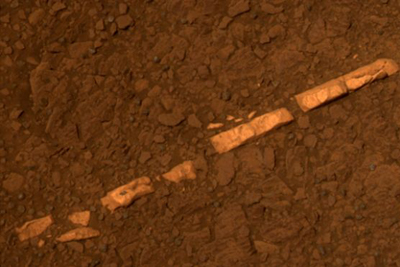Rover's discovery shows water flowed underground on Mars

NASA's Mars Exploration Rover Opportunity has found a bright vein of a mineral, apparently gypsum, deposited by water. Analysis of the vein will help researchers better understand the history of wet environments on Mars.
"This tells a slam-dunk story that water flowed through underground fractures in the rock," said Steve Squyres, Cornell's Goldwin Smith Professor of Astronomy and principal scientific investigator for Opportunity. "This stuff is a fairly pure chemical deposit that formed in place right where we see it. That can't be said for other gypsum seen on Mars or for other water-related minerals Opportunity has found. It's not uncommon on Earth, but on Mars, it's the kind of thing that makes geologists jump out of their chairs."
The findings were presented Dec. 7 at the American Geophysical Union's conference in San Francisco.
The vein examined most closely by Opportunity is about the width of a human thumb, 16 to 20 inches long, and protrudes slightly higher than the bedrock on either side of it. Observations by the rover reveal this vein and others like it within an apron surrounding a segment of the rim of Endeavour Crater.
None like it were seen in the 20 miles (33 kilometers) of crater-pocked plains that Opportunity explored for 90 months before it reached Endeavour, nor in the higher ground of the rim.
Last month, researchers used the microscopic imager and alpha particle X-ray spectrometer on the rover's arm and multiple filters of the panoramic camera on the rover's mast to examine the vein, which is informally named "Homestake." The spectrometer identified plentiful calcium and sulfur, in a ratio pointing to relatively pure calcium sulfate.
Calcium sulfate can exist in many forms, varying by how much water is bound into the mineral's crystalline structure. The multifilter data from the camera suggest gypsum, a hydrated calcium sulfate. On Earth, gypsum is used for making drywall and plaster of Paris.
Observations from orbit have detected gypsum on Mars previously. A dune field of windblown gypsum on far northern Mars resembles the glistening gypsum dunes in White Sands National Monument in New Mexico.
The Homestake deposit, whether gypsum or another form of calcium sulfate, likely formed from water dissolving calcium out of volcanic rocks. The minerals that combined with the sulfur either leached from the rocks or stemmed from volcanic gas. The resulting calcium sulfate was evidently deposited into an underground fracture that later became exposed at the surface.
Throughout Opportunity's long traverse across Mars' Meridiani plain, the rover has driven over bedrock composed of magnesium, iron and calcium sulfate minerals that also indicate a wet environment billions of years ago. The highly concentrated calcium sulfate at Homestake could have been produced in conditions more neutral than the harshly acidic conditions indicated by the other sulfate deposits observed by Opportunity.
Opportunity and its rover twin, Spirit, completed their three-month prime missions on Mars in April 2004. Spirit stopped communicating in 2010.
NASA launched the next-generation Mars rover, the car-sized Curiosity, Nov. 26. It is slated for arrival at the planet's Gale Crater in August 2012.
NASA's Jet Propulsion Laboratory, a division of the California Institute of Technology in Pasadena, manages the Mars Exploration Rover Project for the NASA Science Mission Directorate in Washington.
Get Cornell news delivered right to your inbox.
Subscribe